Dimensions’ rich and interconnected data enables effective analysis of the funding landscape and can be used to evaluate and support potential grant applications prior to submission.
As the pace of science accelerates, finding and securing research funding grows increasingly more competitive. While researchers often prefer spending their time focusing on their work, it’s crucial to invest time in exploring grant prospects to obtain insights that will increase the chances of receiving funds.
The platform helps find opportunities for:
- New collaborations
- Identifying suitable co-investigators
- Finding study funders’ previous awards
- Gauging competitive levels
- Finding ideas for interdisciplinary applications.
How does it work?
Dimensions data can showcase a researcher’s merits and help confirm potential eligibility for a specific application. To demonstrate how the data can be used to find supporting evidence for an applicants’ impact and aid in preparation for future grant applications, we’ll explore the topic of circuit class therapy, an innovative post-stroke therapy, and use impact metrics to develop a broad and insightful view of the funding landscape.
We’ll begin the search by exploring the search term ‘circuit class therapy’ within over 99 million searchable publications in Dimensions. The analytical views tab provides high-level insights and confirms that Australia as a whole has a dominant position in research about innovative post-stroke therapy with the University of South Australia in the lead.
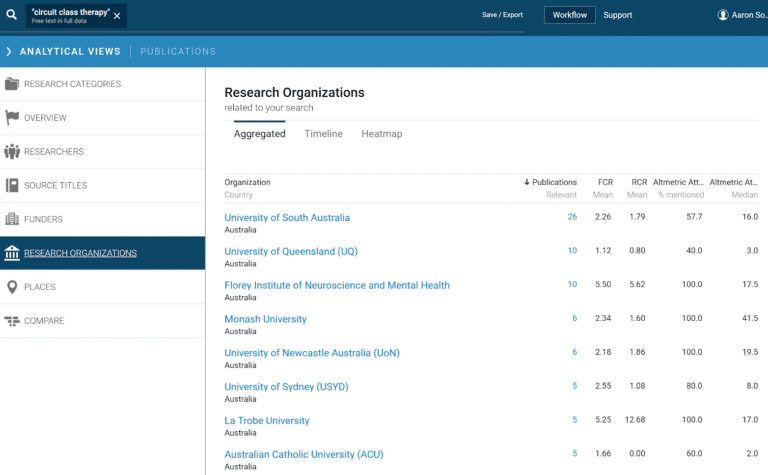
Selecting the researchers tab quickly confirms that the top three Australian researchers who have contributed most publications in the field are Coralie English of the University of Newcastle, Susan Hillier of the University of South Australia and Julie Bernhardt of Florey Institute of Neuroscience and Mental Health.
Digging deeper into the Dimensions profile of the most-published researcher, Coralie English, confirms she’s been awarded over $8 million in funded grants in the past 7 years. In order to make significant progress in a given research topic, you will need to look over a span of years and take into consideration multiple data points from many grants, publications, and clinical trials.
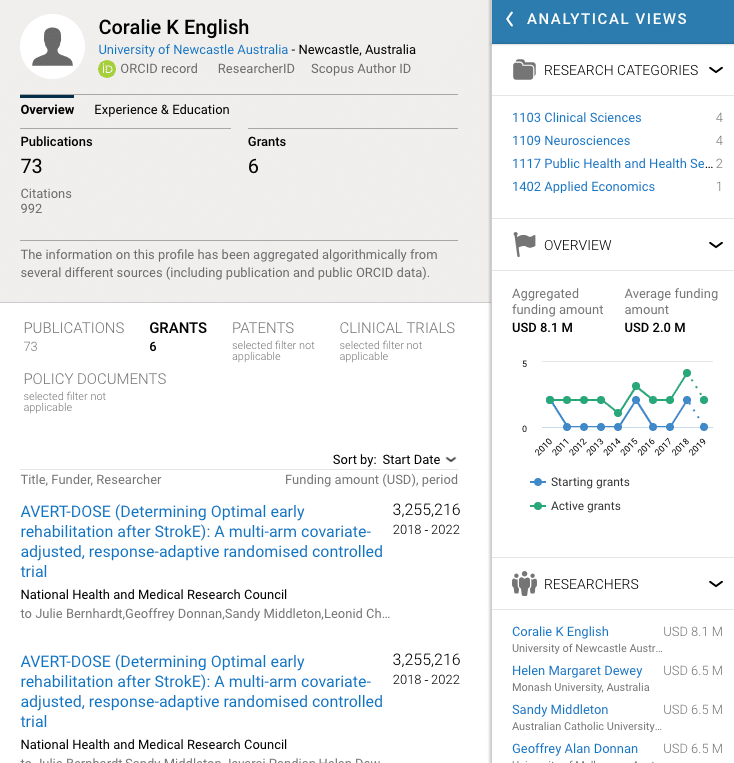
From idea to impact
Dimensions offers an integrated database covering the entire research process from funding to research, from the publishing of results through attention, both scholarly and beyond, to commercial application and policy-making – consistently linked in multiple dimensions. The grants database is an integrated part of Dimensions and paints a broad picture of the entire funding landscape.
Research tends to be more cyclical where grants build on previous grants, publications build on prior publications, and current clinical-trial designs are informed by past clinical-trial outcomes. The circular nature of the research flow illustrates the degree to which different kinds of linked research objects must be woven together chronologically in order to construct a compelling impact narrative. To begin building the circuit-class-therapy narrative, we’ve identified a 2007 publication which reports the results of clinical trials from 2002-03, entitled “Circuit Class Therapy Versus Individual Physiotherapy Sessions During Inpatient Stroke Rehabilitation: A Controlled Trial.”
The first clinical trial may have been a smaller, lower-budget project supported by a combination of internal funds and support from the Australian Physiotherapy Association. This is typical, because often, to get large funding from government funders, you first need to produce preliminary results showing that the scientific approach you are proposing is likely to yield good results.
In the period between the first and second clinical trial, the 2007 publication (a book chapter) got 61 citations providing for impressive RCR and FCR metrics. Also during this time, Susan Hillier and Coralie English published a systematic review on circuit-class therapy in Chochrane, the leading source of clinical guidelines. This is the first indication that their work might be improving patient health beyond the patients that they see themselves.
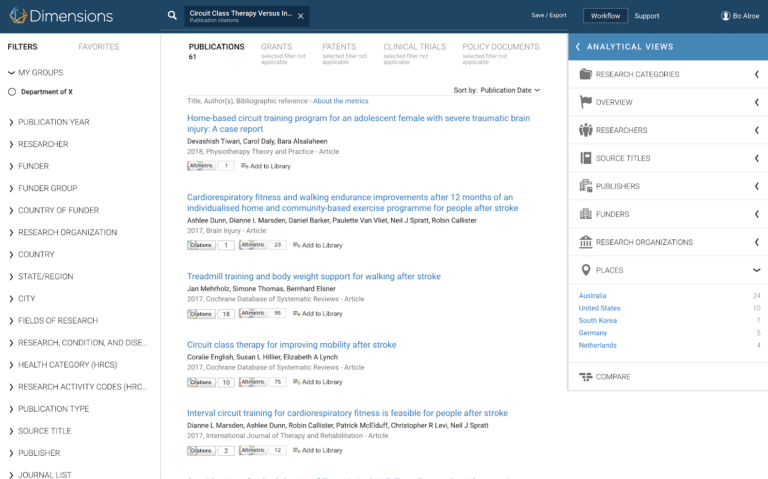
The first sizable grant from a governmental funding agency was awarded to Susan Hillier and her team in 2010. The money from the grant is used to launch a new circuit-class clinical trial. If you look at the affiliations for this grant, you will see that all researchers at the team were based at the University of South Australia. Shortly after the team received the grant, however, much of the team began working for other organizations. Maria Crotty took a position at Flinders, Julie Bernhardt moved to Melbourne, and Coralie English joined the faculty at Newcastle.
Continuing to follow the thread of funding, we can locate a clinical trial registry for the trial which launched with funding from the National Health and Medical Research Council (NHMRC).
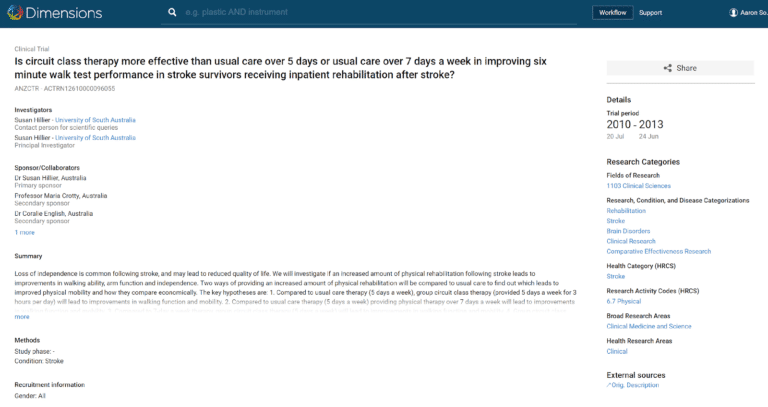
In this phase of the research cycle, Dimensions confirms that Julie Bernhardt is awarded a brand new fellowship grant which may have allowed her to concentrate more of her time on circuit-class-related research. It is the same period that more researchers are joining the research efforts, expanding the list of affiliated universities. Looking further into the grant confirms that Dr. Berhhardt has left the University of Southern Australia and is now at the University of Melbourne.
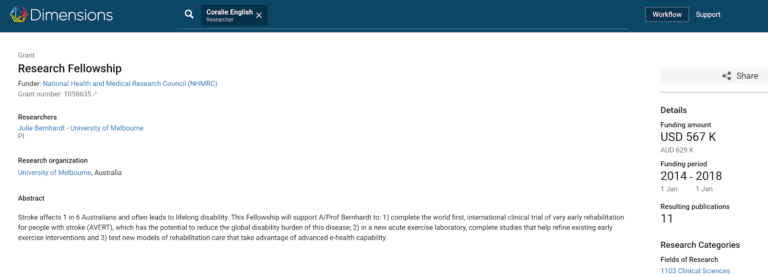
The next logical place to measure potential impact is to examine the amount of attention a publication has received. Dimensions includes high-level Altmetric data for each article in the index and displays this on the article details page. In this way, we can bring together the academic attention (citations), innovation attention (patents), clinical attention (trials) alongside public and policy engagement attention including social media, traditional media, policy attention and the other forms of attention that Altmetric indexes.
An article published in 2015 by Coralie English and her team entitled “Circuit Class Therapy or Seven-Day Week Therapy for Increasing Rehabilitation Intensity of Therapy after Stroke (CIRCIT): A Randomized Controlled Trial” is the first publication to report out on the results of the NHMRC-funded clinical trial. The Dimensions Badge indicates that the publication has a relatively high Field Citation Ratio and is extremely highly cited, receiving approximately 6.33 times more citations than average. Similarly, the Altmetric Badge confirms a high Attention Score and 37 public tweets that link directly to the publication, providing evidence of this work influencing people in the health professions.
Following the publication of the paper reporting the results of the second clinical trial, they published a second systematic review in Cochrane. Exploring the Altmetric information confirms that two scientific blogs have featured the systematic review with one of the blogs being a German-language site. This provides yet more evidence that the circuit-class therapy impact ripples are starting to spread far beyond Australia.
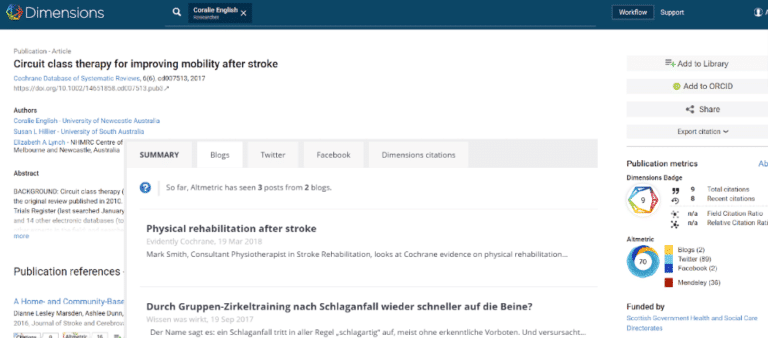
To round out the research cycle, we can explore connected policy documents to see the translation of research into policy adoption. The fact that a UK policy-making group of experts chose to cite the Australian circuit-class research shows, in a very compelling manner, the broader impact it is making internationally in stroke-rehabilitation best-practices.
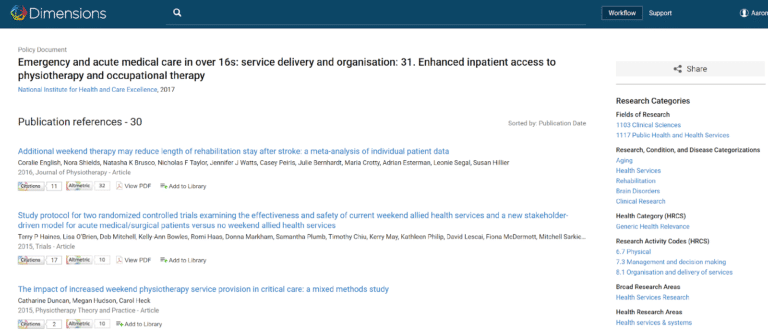
We started our investigation with a small clinical trial from 2002. Although the work continues, we can see this group’s investigative efforts bearing fruit through new funding, online media attention, scientific citations, another clinical trial, additional team members, and clinically-focused publications.
Talk to us and learn how we can help your institution gain insights to enhance grant applications
Are you interested in finding out how Dimensions can benefit your institution? Please contact us and we’ll be in touch soon.
